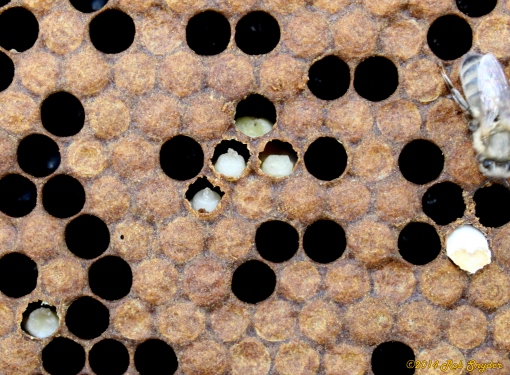
Many diseases and pathogens infect honey bee colonies, but chalkbrood is likely the most common among beekeepers. Ascosphaera apis causes chalkbrood, which is a fungal brood disease. Beekeepers commonly detect chalkbrood in the spring because chalkbrood is considered a stress-related disease. However, chalkbrood is observed throughout the year. Many times, chalkbrood becomes established in colonies because of many interacting factors, such as environmental stressors, genetic makeup of colonies and beekeeping practices. Chalkbrood contaminates larvae when nurse bees admix chalkbrood spores with brood food. The fungal spores out-compete larvae for food and eventually, turn larvae into “chalk-like” mummies. Beekeepers can observe chalkbrood in many colors, ranging from white to grey to black. As larvae turn black, the chalkbrood begins producing fruiting bodies, which are highly infectious. Beekeepers can find these mummies at the entrance or bottom boards, especially if chalkbrood is widespread. At this point these mummies can spread spores to other colonies in the area. Chalkbrood often infects 3-4 day larvae, and can be found as uncapped or capped larvae. If the colony shakes a frame with capped chalkbrood, the frame will rattle when shaken.

Symptoms
- Spotty brood pattern
- Chalk-like (white, grey or black) mummies at the colony entrance, chalk-like mummies in open brood.
- Early stages of Chalkbrood look very similar to Sacbrood Virus. However, the larval head is less defined with a sunken appearance.

Chalkbrood mummies. Photo Courtesy of Rob Snyder and the Bee Informed Partnership

3 Major factors why Colonies have colonies get chalkbrood
- Environmental StressorsChalkbrood outbreaks increase when colonies have a lessened ability to care for brood or maintain the optimal brood temperature of 35°. Remember: Chalkbrood is a stress-related disease, so cold and wet temperatures can proliferate the fungal disease. The following are environmental stressors the may induce Chalkbrood outbreaks:
-
-
- Brood chilling
- When it is cold and wet during spring population increase. Chalkbrood often occurs during rapid growth periods and when the colony has a higher brood:worker ratio.
- Reduced foraging and habitat due to agriculture intensification. Agrochemicals can immunocompromised adult honey bees, which may weaken the honey bees ability to care for brood. Agrochemicals include both agriculture sprayed chemicals and beekeeping miticides.
-
2. Genetics
- Honey bees have significant genetic variation between strains. For example, certain honey bee strains are more resistant to chalkbrood. Because of this, selective breeding for chalkbrood resistance is possible. A great example is hygienic behavior, which have known resistance to chalkbrood.
3. Stressors from other pests, pathogens and diseases
- Chalkbrood is a stress-related fungal disease, and a contemporary honey bee stressor is other pest, pathogens, and diseases. Honey bees can be co-infected with other pests (varroa mites), viral infections (Deformed Winged Virus) and pathogens (American and European Foulbrood), which are stressors that can induced a Chalkbrood outbreak. Below are examples where the co-infection of other pests and pathogens can induce a Chalkbrood outbreak:
-
- Chalkbrood is associated with Deformed Wing Virus, a common virus associated with varroa.
- Chalkbrood outbreaks is correlated to both Varroa destructor and Nosema ceranae.

A mixture of white, grey and black chalkbrood mummies within a heavily infected colony. Photo Courtesy of Rob Snyder and the Bee Informed Partnership
Factors that affect the spread of Chalkbrood
- Virulence
-
- Chalkbrood virulence (the severity of harmfulness of the disease) is dependent upon the strain. A more virulent strain of chalkbrood will spread and kill a colonies more quickly. Remember: not all chalkbrood is the same and some strains are more virulent than others.
- Social Immunity
-
- Colonies bred for hygienic behavior have a reduced prevalence of chalkbrood. But, remember, hygienic behavior is most effective during early detection of chalkbrood, which means the early detection of larval death. If chalkbrood is detected during the late stage and potentially sporulation chalkbrood mummies are removed, hygienic behavior could increase rather than decrease transmission of chalkbrood spores.
- Beekeeping Practices
-
- Management and sanitation practices should aim to reduce transmission
-
- Keep equipment clean to avoid transfer of chalkbrood among colonies
- Either removed old comb from your operation or avoid the transfer of contaminated comb among colonies.
- Reduce Stressors
-
- Reduce environmental stressors, such as low forage, nutritional limitation, and agrochemical exposure
- Reduce co-infections with other pest, pathogens and diseases.
- Breed bees for hygienic behavior or select bees for chalkbrood resistance
-

3-4 day old larvae infected with Chalkbrood, a common fungal disease. Photo Courtesy of Rob Snyder and the Bee Informed Partnership.
Prevention
- Increase ventilation and airflow into colony
- Replace and removed old comb. Old comb contains spores and is often the source of a chalkbrood outbreak. Be cautious when buying old equipment and comb.
- Re-queen colonies with queens bred for hygienic behavior
- Maintain strong colonies
Treatment
- Thymol based treatments are thought to effectively treat chalkbrood. But this is purely anecdotal. Thymol based treatments include apiguard, Vitafeed Green and beevital are commonly used, and many beekeepers believe they are effective. While these thymol based treatments may work, I have not seen it.
Cheers,
Garett Slater